Introduction #
XML (Extensible Markup Language) is one of the document formats that has a certain structure (tag). And this structure can only be read properly by a system. As for its connection with OJS, this XML file is usually used as one of the requirements for indexing an article from OJS to certain indexing institutions such as EBSCO, PubMed, DOAJ, and others. With the XML file, the data transfer process from the OJS platform to the indexing system can take place accurately and in a structured manner.
The important question is how urgent is XML? Based on the analysis and various data that we found, the fact is evident that the XML format is gradually becoming a mandatory requirement for indexing on several reputable indexing platforms. Initially, XML may only be provided to be able to present full-text in an OJS (assisted by the e-Life Lense viewer plugin to display full-text). However, approaching 2025, we found the fact that several indexings are starting to require XML, one of which is PubMed. PubMed requires that in order for an article to be indexed, it must be in XML format and must even meet PMC or DTD standards such as the following points:
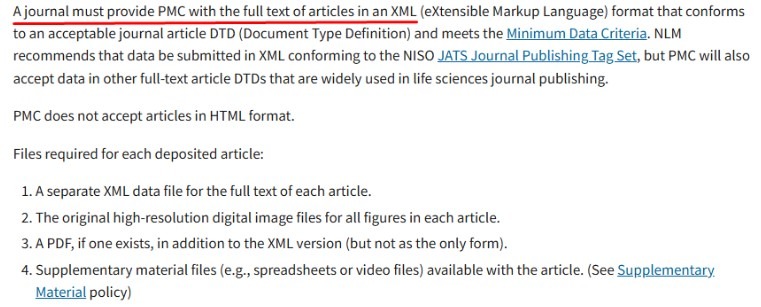
Creating XML files can be quite challenging, especially for individuals who are not yet familiar with XML and the various structural standards it requires. Without proper handling, the process of generating XML files can take a significant amount of time. Based on the experiences of our clients, converting a 1 article into XML format can take up to 2 days. This does not include the additional complexity of dealing with tables, which often require even more effort. Tables are one of the more difficult elements to implement in XML, making this process spending a lot of time.
We don’t want to leave you feeling stuck or overwhelmed in the process of creating XML. As a form of our commitment and concern for the needs of all publishers, we have conducted a series of in-depth analyses, considered various options, and developed solutions related to tools that can make XML creation easier. We want the entire XML creation process to be more seamless, even easier than you might think.
In this article, we will explain various tools designed to create XML files more efficiently and effectively. Each tool we present has different features and functions, so you can evaluate and choose which one best suits your specific needs.
Important Considerations in choosing XML tools #
Creating XML files is not just about changing and editing a document with the final result being an XML file. However, there are various considerations that need to be considered, especially in considering which XML tools are most appropriate for you to use. Moreover, not all XML tools out there can produce XML file formats or structures (tags) that comply with indexing standards especially PMC and DTD’s standard. You may encounter various difficulties in the future that will only take up your time.
To make it easier for you in this matter, we will explain various principles or considerations that you can use as guidelines in choosing XML tools. Here are some important considerations in choosing XML tools.
1. Compatible with indexing standards (PMC or DTD)
This is the first very important point, namely we need to ensure that the XML tools used are capable of producing XML files that have met the standards of various indexing institutions such as PubMed Central (PMC) and Document Type Definition (DTD). Why is that? Inadequate tools will only produce XML files with inappropriate and invalid structures, of course the resulting XML files will be rejected by the indexing institution. This is a very important standard, to ensure that all structures such as metadata, references, tables and other elements can be accepted properly by the indexing. If this XML file has an invalid structure, it is very likely that your article will be rejected for indexing and in the long term will affect the visibility and reputation of your journal.
2. Can be reused or modified
An XML tool will be quite powerful if the XML file produced can be reused or re modified. This is also an urgency that we need to consider. In some cases, we often find that articles that have been published sometimes have changes in content or metadata in the future. Imagine if you only use another vendor to produce this XML and when modifications are needed, you need to re-request the XML file. Of course, this is very expensive and ineffective. If you choose an XML tool with this reuse or remodification capability, then you will no longer depend on external parties so that you have full control over this. On the other hand, this will also speed up the revision process so that you can change any part you want with the aim of meeting the indexing standards.
3. Supports multiple formats or structures
Scientific articles generally consist of several formats such as text, images, and tables. You need to know that these elements are standard elements, moreover there are more complex structures especially tables. An XML tool must be able to process these elements better. From time to time the format of this article continues to develop. It is possible that the presentation of ORCID links, video embeds, and other multimedia elements is needed. The good news! in this article is that we have found XML tools that support these multiple structures. So you can add more complex elements in an easier way.
4. Automatic Conversion for Tables, Images, and References
Tables, images, and references are one of the fairly complex structures in an article. With XML tools that can handle this automatically, you don’t need to spend more effort. Moreover, this will save you time. So you can import a table, image, or reference more seamlessly with one-click and all will be read by the system in the XML tool automatically. How urgent is this? This is very important, considering that tables, images, and references are representative of an article. If there is writing incorrectly (due to making it manually) it can affect the validity of the article in the future. The plus point is that in addition to saving time, this automatic conversion feature will also make it easier for you to meet the standards set by PMC and DTD.
5. Can be integrated with or without OJS
An XML tool must be flexible. In this case, it means that the tool can be used in various conditions. First, XML tools should be able to be integrated with the Open Journal System (OJS). As we know, OJS is a scientific publication platform that is quite widely used. When an XML tool is able to integrate with OJS, it will make it easier to export or import metadata, and various other elements quickly and easily. So with one-click you can easily change article metadata in OJS into XML format.
On the other hand, the XML tool must also function as an independent platform. This means the tool should be able to operate as a standalone system without relying on other systems. This is particularly important because several publishers may use platforms other than OJS for article publication. By having an XML tool that works independently, it becomes easier for anyone to adapt it to the specific needs of their chosen platform, regardless of the system they use.
6. Support for ORCID ID
The ability to attach ORCID ID in XML files is quite an important urgency. In a scientific article, this ORCID ID plays an important role in ensuring the accuracy of the author’s data, as well as increasing the credibility of the author. With the ORCID ID listed in this XML file, it will further enrich the XML data. Moreover, with the ORCID ID in the XML file, it will make the file more systematic and easily accessible by various indexing such as PubMed, DOAJ, EBSCO and others that really need clear author data or attribution.
7. Cost
Another consideration that needs to be considered when choosing XML tools is the cost. You need to know that the costs for creating XML files by several existing vendors are usually quite expensive. One publisher once informed us that when he used another vendor or company that could create XML files, the costs offered were quite expensive. He honestly said that the rate they charged to create XML files was around $1200 USD for only generating 10 articles. Of course, this can be said to be a fairly fantastic cost and is difficult to reach, especially for newcomer publishers.
Actually, there are also some free XML tools. We have analyzed and tried them in depth. But unfortunately, these free XML tools are so far not worth it. Some of the obstacles found are not supporting complex table formats, frequent errors, unclear compatibility, not meeting PMC and DTD standards, manual data input, and various other crucial obstacles.
You don’t need to worry!!! There are also several XML tools that offer more affordable costs and you can even choose whether you want to create the XML files by yourself or have it done entirely by them. And their XML tools meet PMC and DTD standards. We have also attached this in this article as well. Just read this article carefully.
8. Comprehensive Documentation
XML tools must be able to provide complete documentation on how to use the tool. So that anyone can easily adapt and use the tool, especially for those who are new to XML. Moreover, XML consists of various structures, so complete documentation is needed on how to implement each structure step by step neatly and clearly. This is also useful to ensure that each user not only understands the basic functions, but is expected to be able to use and handle all more complex elements such as tables, references and various other structures more systematically. On the other hand, without a clear document, this only makes it difficult for users and even has the potential to produce unclear and invalid XML files, especially to meet PMC and DTD standards.
Top 5 XML Tools for Simplifying XML File Creation #
Quick Comparison: #
| Feature | Texture | JATS Editor | Oxygen | Pandoc | JATS Generator |
| Integrated with OJS | ✓ | ✓ | X | X | X |
| Free | ✓ | X | X | X | ✓ |
| Documentation is available | ✓ | ✓ | ✓ | not complete | not complete |
| GUI-based application | ✓ | ✓ | ✓ | Command Line Interface | Command Line Interface |
| Supports media insertion (Figure and Video) | does not support video insert | ✓ | ✓ | X | X |
| XML structure according to standard | X | ✓ | ✓ | Χ | X |
| Auto-save feature | X | ✓ | ✓ | X | X |
| Auto Reference | X | ✓ | X | X | X |
| Support maths-equation | ✓ | ✓ | ✓ | Χ | Χ |
| Include Viewer | X | ✓ | X | X | X |
| Comprehensive metadata support | X | ✓ | ✓ | X | X |
| Complex support table | X | ✓ | ✓ | X | X |
1. Texture #
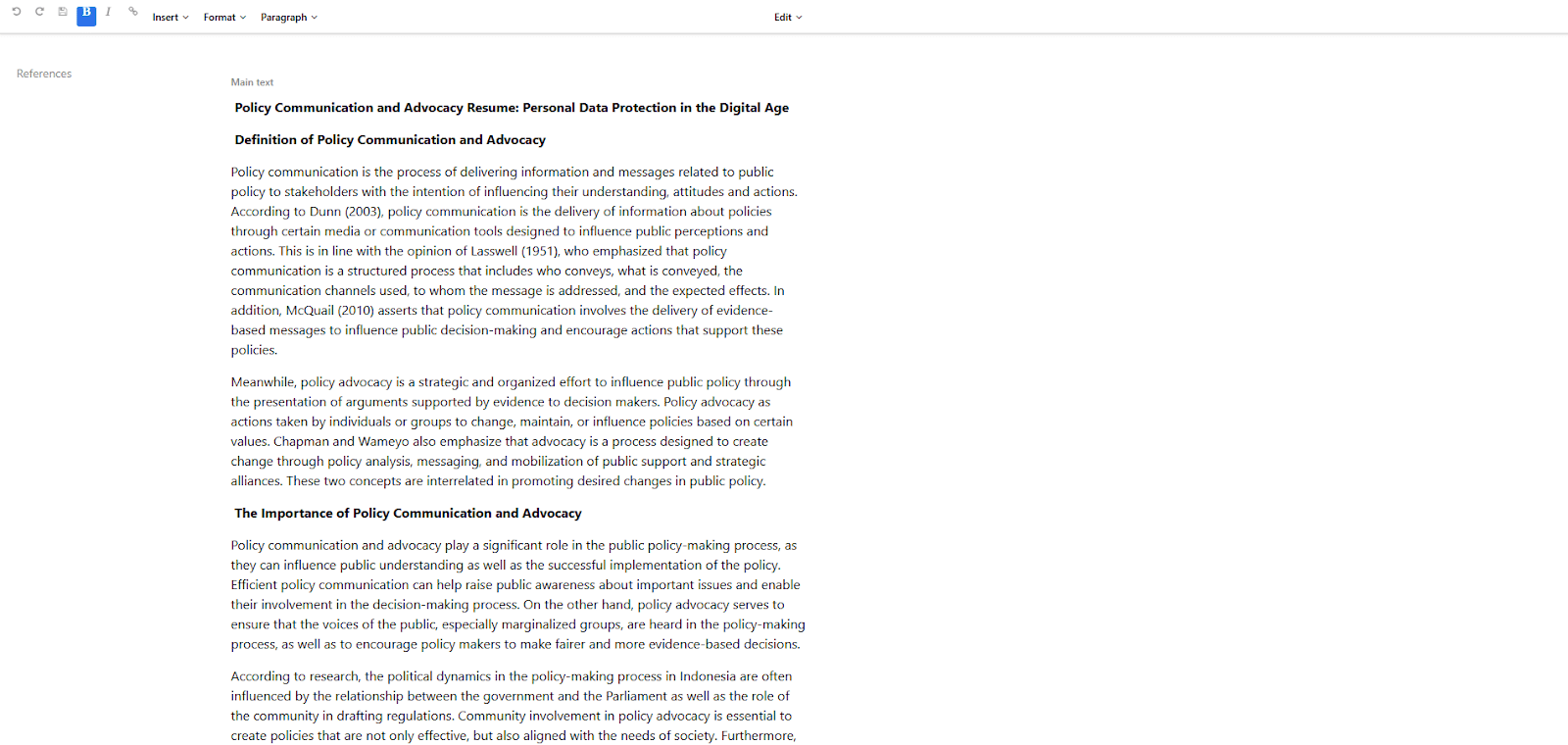
Texture is a plugin that integrates the JATS XML editor with the OJS workflow. It allows direct editing of JATS XML documents within OJS, allowing editors and reviewers to work more efficiently in managing and editing journal articles.
The advantages of Texture include: #
Directly integrated by OJS
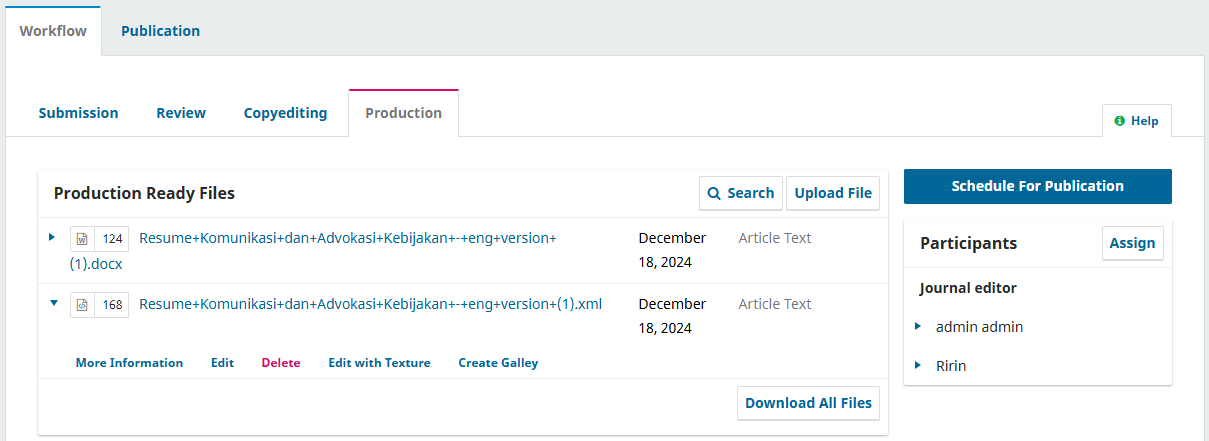
Texture has been integrated into the OJS workflow stages, such as Review, Copyediting, or Production. Therefore, editors or copyeditors can open manuscript files directly within the OJS system without downloading the file, open it with external software (such as Microsoft Word or a specialized XML editor), and re-upload the edited file.
Open source
Another advantage of Texture is that it is free to use, requiring no licence or subscription fees. This is of great benefit to scholarly journals and publishers who may have limited budgets. With Texture, editors and authors can easily edit and format JATS (Journal Article Tag Suite) documents without incurring additional costs.
User-Friendly Display
Apart from being free, Texture’s advantage in Open Journal Systems (OJS) is its user-friendly interface. This intuitive interface is designed to make it easier for users, both editors and authors, to manage and edit journal articles.
The disadvantages of Texture include: #
Limited Metadata Flexibility
Texture has limitations in customising metadata that may be needed by some publishers or journals with specific requirements. One of them is the absence of affiliation for ORCID and Scopus Author ID so that it must add it manually.
Less Documentation
One of the major limitations of ‘Edit with Texture’ is the lack of comprehensive documentation. The absence of a detailed user guide makes it difficult for new users to understand all the features and how to use them effectively.
No List Navigation Menu

This can make it difficult for users to navigate through different parts of the document and make editing slower and less efficient. The absence of a table of contents or quick navigation that allows users to jump directly to specific sections of the document, as well as navigation between elements such as tables, images, and references that are less intuitive and require more clicks or steps than ideal, further adds to the difficulty in use.
Long Workflows
Users face a long and inefficient workflow when using Texture. Every time they want to create an XML file from one article to another, users have to go through several steps, namely Users must first go to the submission section, then they have to move to the archive section and users must search for the desired article name. Another problem is that all articles are organized in one place without a clear structure, making the process of searching and managing articles more difficult and time-consuming.
Limitations on the Table
Texture cannot handle very complex tables with many rows and columns or tables that have complex hierarchical structures, and inserting media elements, such as images or graphics, into table cells may not be supported or require complex manual customization.
XML structure is not PMC and DTD compliant

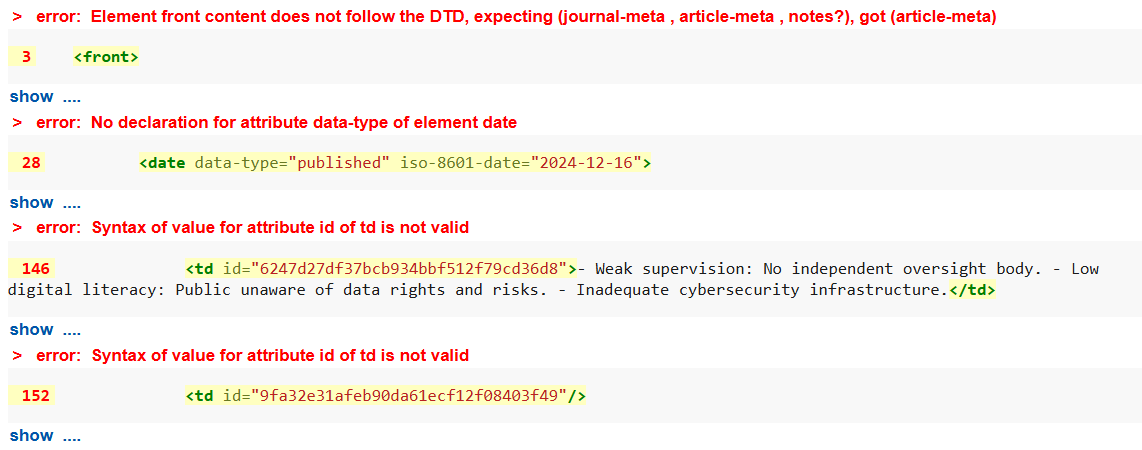
PubMed has strict standards for XML validation, and Texture does not yet support all the required validation schemes.
Style Limitations on References

For journals that use complex reference management systems or specialized citation formats, Texture may not fully support all such needs. It could require manual modifications to ensure compliance with the desired citation standards. In addition, creating references manually is time-consuming and inefficient.
No auto-save
Another addition is that Texture does not yet have an auto-save feature, which can be an important drawback in document editing. The lack of an auto-save feature increases the risk of losing unsaved work in the event of an outage or technical glitch. Users have to remember to save changes manually, which can be inefficient and risky.
2. JATS Editor #
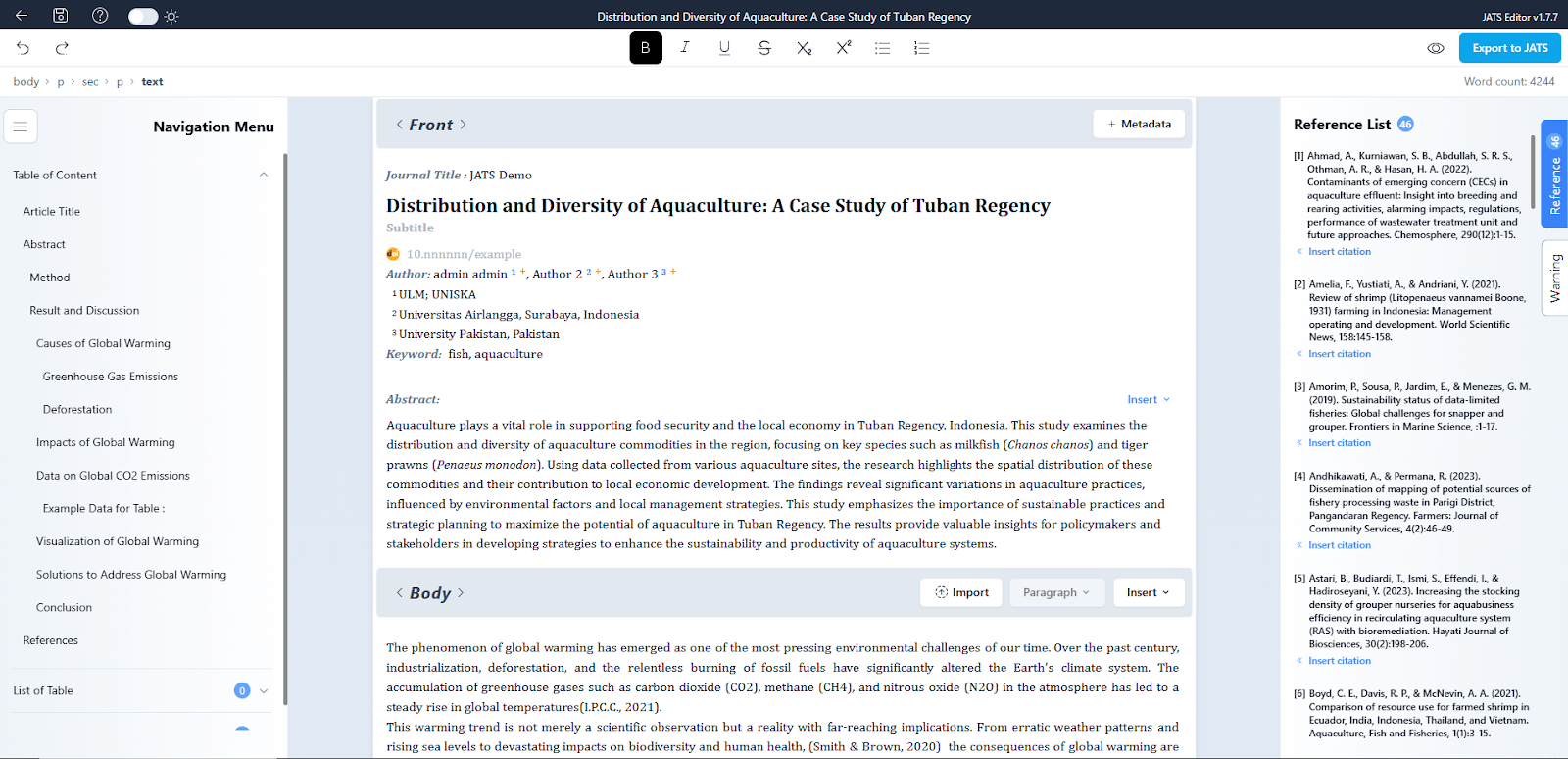
JATS Editor is the first AI-powered editor designed to simplify the creation of JATS files, facilitating indexing on platforms such as EBSCO and PubMed. Seamlessly integrated with OJS, the plugin automatically syncs important metadata such as DOI, authors, and references from OJS to JATS, saving time and minimizing errors.
The advantages of JATS Editor include: #
Comprehensive metadata
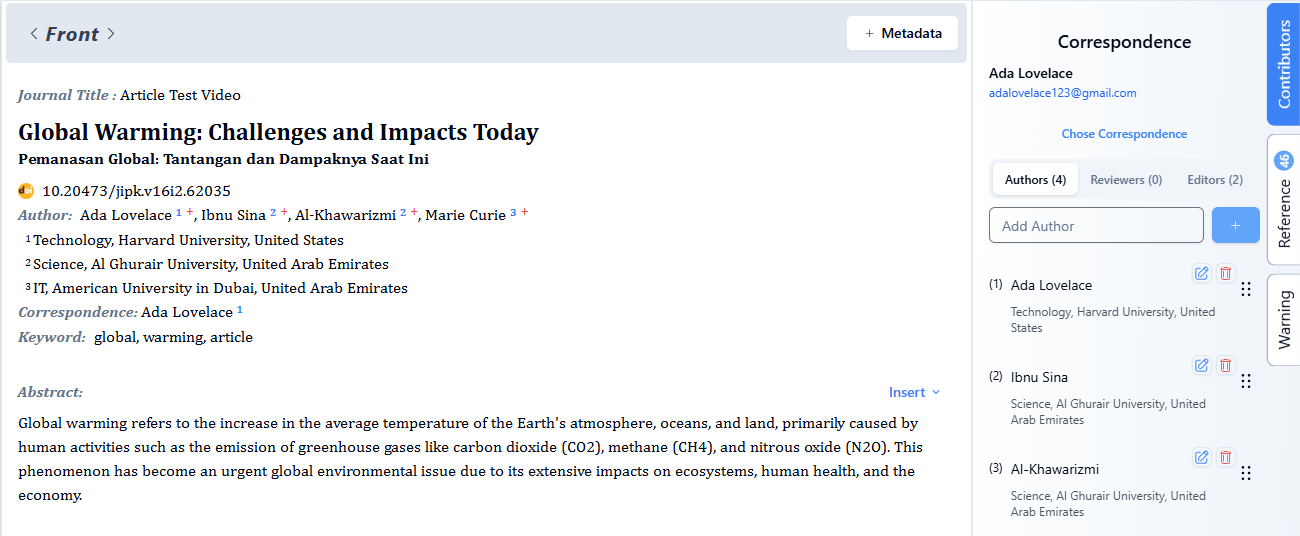
All metadata required for indexing on platforms such as EBSCO and PubMed are included automatically. This includes information about authors (including ORCID ID and Scopus ID), article title, abstract, keywords, and more. The plugin also automatically synchronizes important metadata such as DOI, authors, affiliations, references, and other information from OJS into the JATS XML format.
Content Re-use
Users can reuse content and easily update reused content.
Comprehensive Documentation
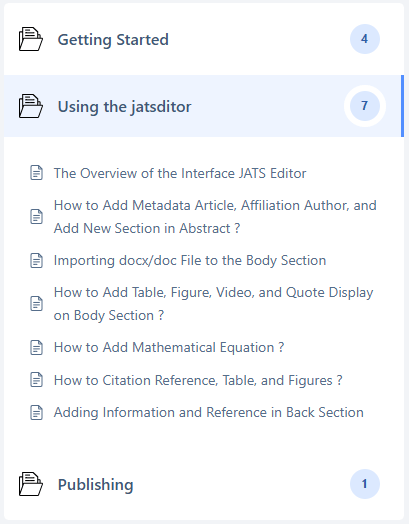
For a complete description of the JATS Editor’s features, how to install it, and how to use it, it is available on the jatseditor.com website. Users can find guides, tutorials, and detailed information about the various features and how this plugin works so that users will not be confused about using it and can utilize all available features more efficiently.
Available Menu Navigation and Reference List

JATS Editor also provides Menu Navigation and Reference List features that help in the management of scientific articles. Users can easily jump directly to a specific part of the document without having to scroll through pages one by one. This greatly facilitates editing and reviewing long documents. A reference list makes it easy for users to manage citations and references in articles. It ensures all cited sources are recorded correctly and according to standards.
Fast Workflow
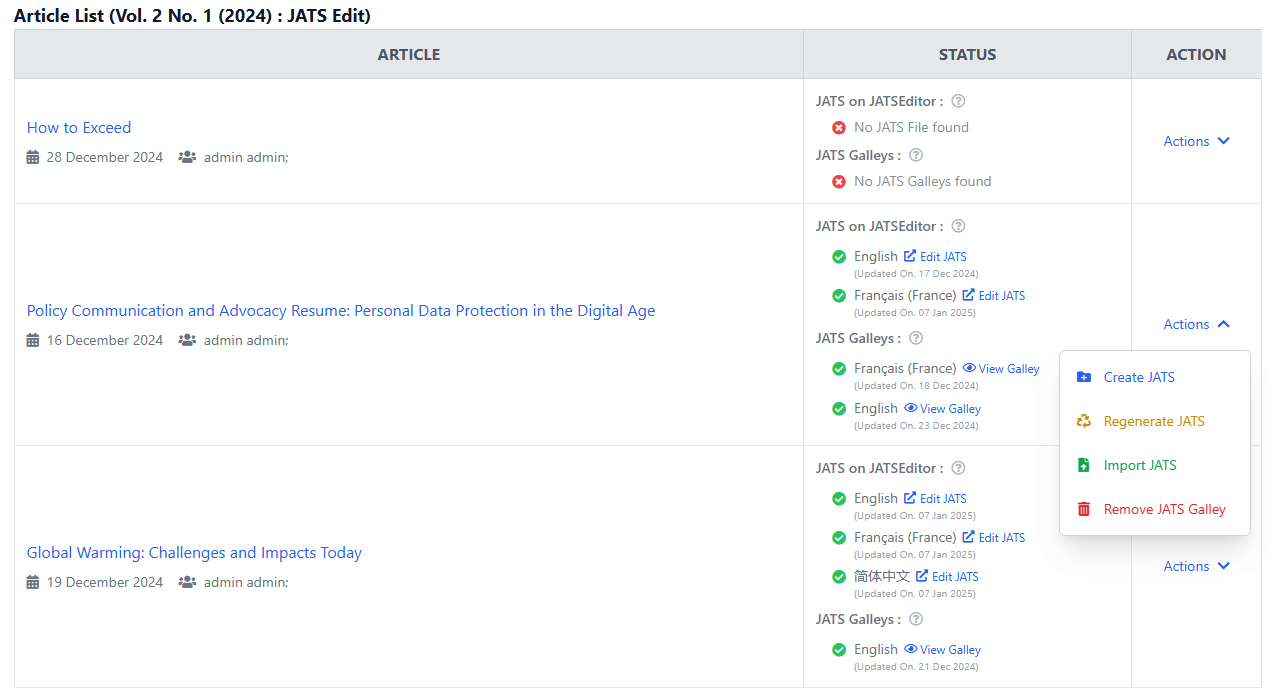
If you want to create XML from one article to another, you just need to press ‘Issue’ and select the article you want to edit. All articles are neatly arranged in the Issue menu, so users can easily access and edit the desired article without wasting time. With this, users know which article we are editing without confusion.
Auto-save Feature
The autosave feature in JATS Editor is very helpful in keeping work safe and preventing data loss due to technical errors or other disruptions. With autosave, users do not have to worry about manually saving changes every time they make an edit. Users can focus on editing without having to be distracted by having to manually save work repeatedly.
Import Complex Table
This plugin can import complex tables with many rows and columns without losing their original structure and formatting. This ensures that the data in the table remains accurate and can be used effectively in JATS documents. Once the tables are imported, users can easily edit and modify them in the JATS Editor, adding or deleting rows and columns, and customizing the content as needed with ease. The JATS Editor ensures that imported tables conform to JATS standards and XML validation so that the resulting documents are ready for indexing on platforms such as PubMed and EBSCO.
Auto Reference and Multi-Format Support
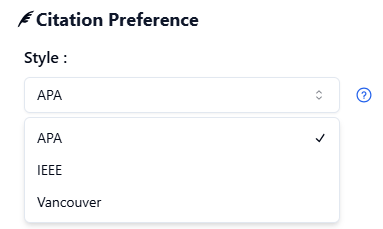
JATS Editor automatically synchronizes references from Documents into the editor during the import process, reducing the need to manually enter citations. Users can easily add, edit, or delete references directly within JATS Editor, which simplifies the reference management process. Not only does it support auto-referencing but also various citation format styles. Currently, JATS Editor supports several citation format styles such as APA, IEEE, and Vancouver.
XML structure according to PMC & DTD standard

By using structures verified by PubMed and DTDs, JATS Editor ensures that the resulting articles will be ready for indexing in influential indexing platforms such as PubMed.
The disadvantages of JATS Editor include: #
Doesn’t Support Multi-Files Edit
One of the limitations of JATS Editor is that it does not support editing multiple JATS files at once (multi-files). This means that each JATS file must be edited/created individually. However, this is not a problem.
No Direct Deposit Feature to Pubmed
Currently, JATS Editor does not have a feature to deposit directly to PubMed. This means that once a JATS file has been created and verified, users still have to manually upload it to the PubMed system for indexing. This limitation means that the process of making an article available in PubMed requires additional steps that can take extra time and effort from the user.
3. Oxygen XML Editor #
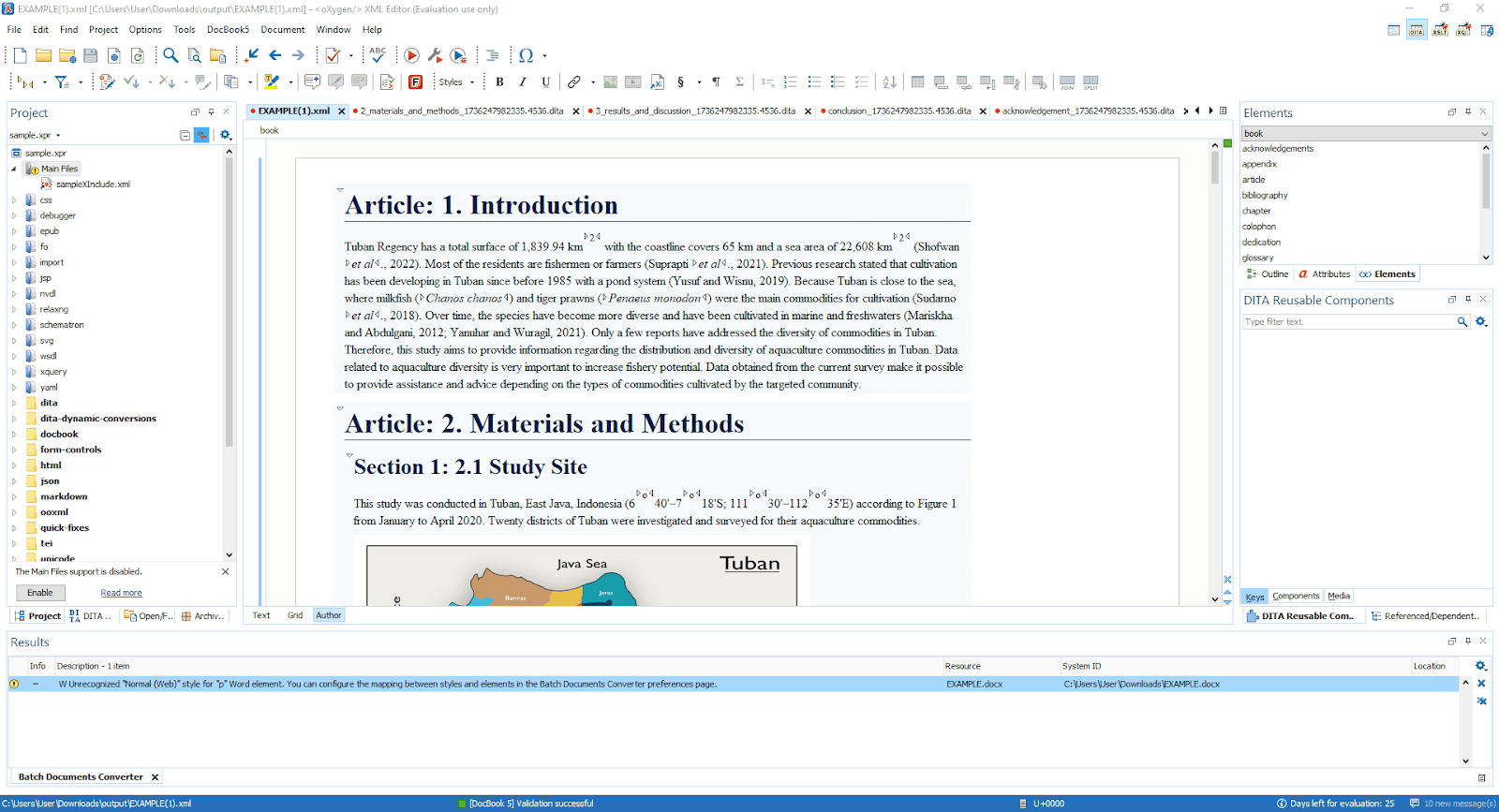
Oxygen XML Editor is an XML editor software designed to make creating and managing XML documents easier.
The tool supports various standard frameworks such as DITA, DocBook, TEI, XHTML, and many other output formats such as PDF, ePUB, and HTML.
The advantages of Oxygen XML Editor #
Comprehensive XML Standard Support
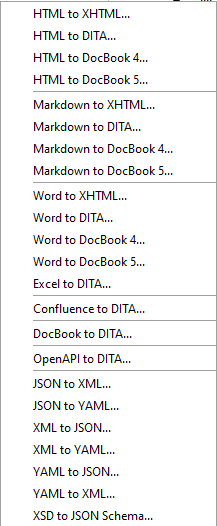
It supports complex XML standards, including XML, XSLT, XPath, XQuery, XSD, DTD, Schematron, and more. This ensures compatibility with a wide range of document types and XML workflows.
Complex Display Interface
Oxygen XML Web Author is designed with an adaptive and innovative interface, allowing users to edit and create XML content efficiently and productively.
Spell-checker feature
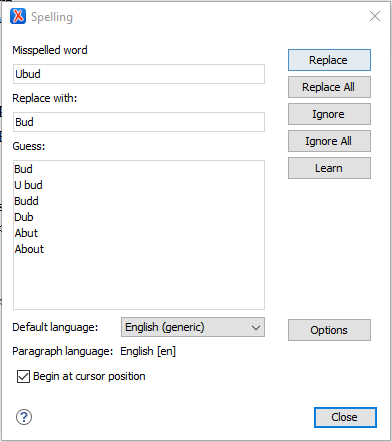
You can customize the behavior of the spell-checker, such as ignoring certain words, adding words to your personal dictionary, or changing the language used. Spell-checker will check your document in real-time as you type, making suggestions and flagging sentences that are not quite right.
Disadvantages of Oxygen XML Editor #
Expensive Prices
Oxygen XML Editor is commercial software with a relatively expensive license price. This can be a consideration for individual users or institutions with limited budgets.
Incomprehensible User-Interface
Oxygen XML Editor has many complex features and settings, so it takes time and effort to learn it thoroughly. For users who are new to XML or only need basic features, the Oxygen XML Editor interface may feel complicated and confusing.
High system resource consumption

Oxygen XML Editor can consume a lot of system resources, especially when processing large or complex XML documents. This can lead to slow performance on computers with low specifications.
Dependency on plugins

Some features or functionality of Oxygen XML Editor can only be accessed or enhanced by installing additional plugins.
4. Pandoc #
Pandoc is a command-line document processing software. Pandoc is often used primarily by academics as the basis for publishing workflows because of its ability to convert documents between formats easily. Pandoc can be used to edit the content of an article, provided you convert it to Markdown first.
Display on Pandoc

Result of conversion to Markdown
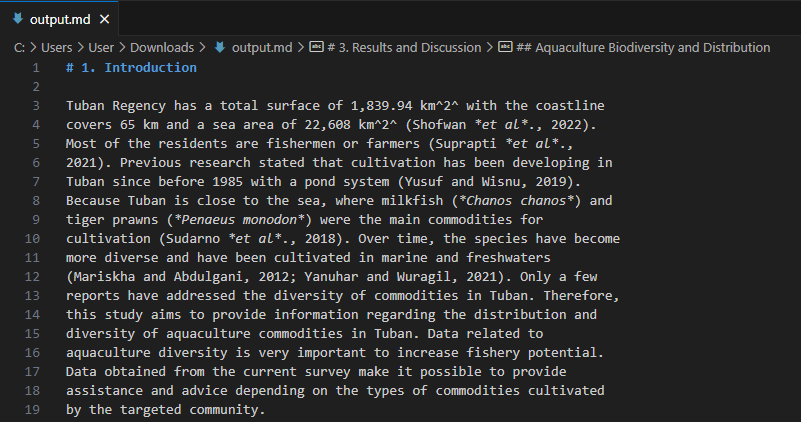
The advantages of Pandoc #
Open Source
Pandoc is open-source software, which means it is free to use and distribute.
Supporting Article Metadata
Pandoc supports JATS XML metadata, which allows users to add information about their articles, such as title, author, abstract, and keywords.
Conversion of Various Formats
Pandoc can convert from various document formats to JATS XML, including Markdown, HTML, and LaTeX. This allows users to write their articles in their preferred format and then convert them to JATS XML.
Disadvantages of Pandoc #
Non-standard Structures
The XML generated by Pandoc is not 100% compliant with the JATS standard. So, users need to do a lot of manual adjustments so that the XML is valid and in accordance with the desired JATS schema.
Less ‘lay’ user-friendly
Pandoc is run through the command line/terminal, which may be unfamiliar to ordinary users who are used to graphical interfaces. Pandoc may also display errors or warnings that are difficult to understand for the average user.
Command-line interface complexity
Pandoc is operated through the command-line interface (CLI), which may be unfamiliar to some users. Users may need to learn the syntax and options of Pandoc to use it effectively, which will take time.
Need to do manual editing
Users need to do manual editing on the XML generated by Pandoc. For example, changing element names to match JATS or adding missing elements, must be done manually and must check/validate it so that there are no errors.
Lack of documentation
Although Pandoc’s documentation is quite comprehensive, some users have complained that it is not user-friendly, especially for beginners. The documentation is sometimes too technical and difficult to understand, making it difficult for users to find the information they need.
5. JATS Generator (elife science) #
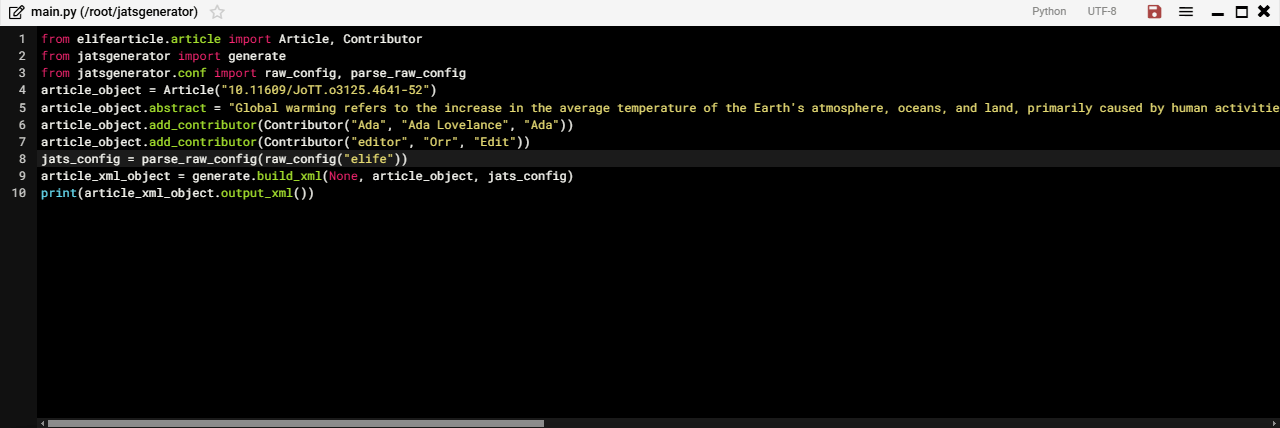
JATS generator from eLife Science is a Python library that can be used to create JATS XML files from journal article data. JATS generator can generate JATS XML output for various article elements, including journal metadata, article metadata, author information, affiliations, and more.
The advantages of JATS generator #
Open source
JATS Generator is open-source software that is freely available. This means anyone can use, study, modify, and distribute this library without restriction.
Easy to Install
For users who are familiar with Python, the JATS Generator installation process will be very easy. Once installed, the JATS Generator can be directly integrated into your existing workflow.
Disadvantages of JATS generator #
Lack of support for article content
While JATS Generator can easily process information such as title, abstract, author, affiliation, and so on, it is not yet capable of processing the content of the article itself, such as text, images, tables, and other elements that make up the main body of the article. So, if you have an article in DOCX or HTML format that you want to convert into JATS XML, JATS Generator will only assist you in creating the basic XML framework.
Less Documentation
Currently, available documentation may only provide basic information on simple installation and usage. Detailed information on specific functions, how to configure libraries, or troubleshoot certain issues may be difficult to find or even unavailable. The lack of clear use cases and in-depth tutorials can also make it difficult for users to understand how to implement the JATS Generator in different contexts. For example, how to process complex input data, customize XML output as needed, or integrate JATS Generator with existing systems. As a result, users may need to spend more time experimenting, reading source code, or seeking information from other sources to use the JATS Generator optimally.
Difficult to use for ‘lay’ users
Using JATS Generator can be challenging for lay users who have no experience with the Python programming language or the JATS XML format. This is because JATS Generator is designed as a Python library, which means users need to have a basic understanding of how to write and run Python code. Lay users may find it difficult to install the library, import modules, create objects, and run the functions required to generate JATS XML. In addition, JATS XML itself is a fairly complex format with detailed structures and rules. Lay users who are not familiar with JATS XML may find it difficult to understand how the JATS Generator works, interpret the resulting XML output, and make modifications or adjustments as needed.
Lack of advanced features
JATS Generator currently focuses on creating basic JATS XML elements. Advanced features such as cross-referencing, quote display, or support for complex math equations may still be limited.
Restricted validation
Although the JATS Generator generates syntactically valid XML, it may not perform deep semantic validation. That is, the generated XML may be technically correct, but it does not match the specific requirements of the journal.
Conclusion #
In the world of scientific publishing that increasingly relies on the JATS XML format, the existence of software that facilitates the process of creating and managing JATS documents is very important. Various software and plugins have emerged with their own advantages and disadvantages. Texture, for example, offers direct integration with OJS and is free to use, but has limitations in metadata and navigation flexibility. Oxygen XML Editor, on the other hand, comes with comprehensive XML standard support but has a relatively expensive price and complex interface.
Pandoc, with its multi-format conversion capabilities and metadata support, demands more technical knowledge for lay users. Meanwhile, eLife Science’s JATS Generator, although free and easy to install, has limitations in supporting article content and documentation.
Amidst these options, JATS Editor emerged as a promising solution. Its ability to simplify JATS file creation, auto-complete metadata, and streamline workflows makes it a viable option, especially for users who want efficiency and ease of use. While not perfect, JATS Editor is constantly being developed and updated to meet the evolving needs of users.
It is important for users to consider their needs and resources before choosing the most suitable platform. Each software has unique characteristics that can affect the efficiency and effectiveness of the publishing workflow.



